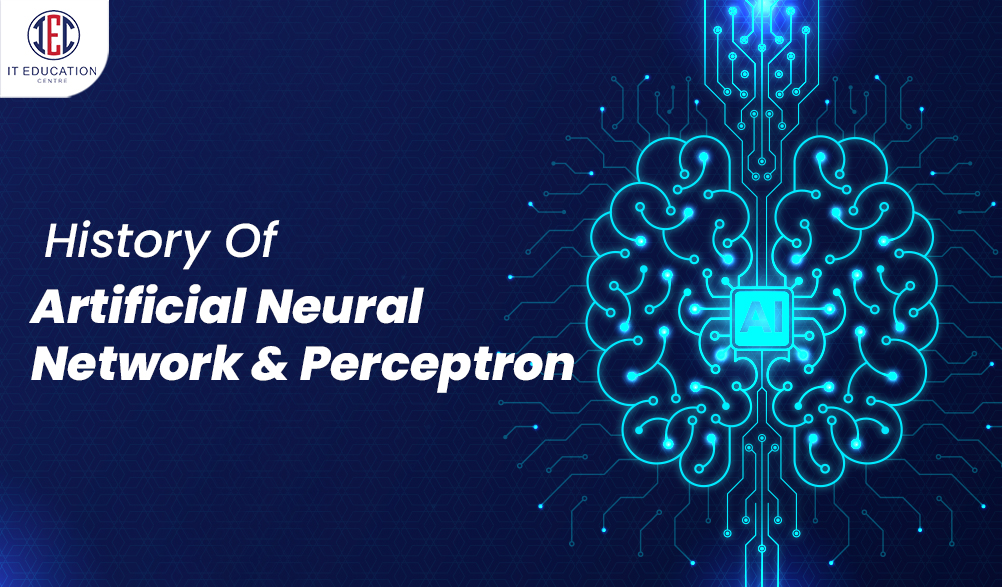Artificial Neural Networks (ANNs) are a type of machine learning algorithm that is modeled after the structure and function of the human brain. The basic unit of an ANN is a single artificial neuron, which receives input signals, combines them using a weighted sum, and produces an output signal based on a threshold function.
The perceptron algorithm is a specific type of artificial neural network that is used for binary classification tasks, which involve predicting whether an input belongs to one of two categories. The perceptron algorithm was developed in the late 1950s by Frank Rosenblatt, and it was one of the earliest examples of a supervised learning algorithm.
The perceptron algorithm is based on the concept of a single artificial neuron, which receives input signals, combines them using a weighted sum, and produces an output signal based on a threshold function. The weights of the input signals are adjusted during training using a gradient descent algorithm to minimize the error between the predicted output and the true output.
Before the development of the perceptron algorithm, other types of machine learning algorithms were used for classification tasks, such as the Bayes classifier and the nearest neighbor algorithm. However, these algorithms were limited in their ability to learn from training data and generalize to new data.
The perceptron algorithm was an important breakthrough in the field of machine learning, as it demonstrated the ability of artificial neural networks to learn from training data and make accurate predictions on new data. However, the perceptron algorithm was limited in its ability to solve more complex classification tasks, as it could only classify linearly separable data.
After the development of the perceptron algorithm, researchers began exploring more complex neural networks architectures, such as multi-layer perceptrons and convolutional neural networks, which can handle more complex classification tasks. Multi-layer perceptrons contain multiple layers of artificial neurons, and they are capable of learning non-linear decision boundaries between classes. Convolutional neural networks are designed for image and video processing tasks, and they contain specialized layers that can learn features directly from the raw pixel values.
Today, neural networks are a widely used machine learning technique, and they have been applied to a wide range of applications, including computer vision, natural language processing, and autonomous vehicles. ANN-based models have demonstrated state-of-the-art performance in many challenging tasks, including object recognition, speech recognition, and machine translation.
In summary, the development of ANNs and the perceptron algorithm paved the way for the development of more advanced neural network architectures that can handle more complex classification tasks. Neural networks are now one of the most widely used machine learning techniques, and they have enabled significant advances in many fields.
How Logic Gates Can Be Implemented Using Perceptron
Logic gates can be implemented in a perceptron by setting the input signals to either 0 or 1 and adjusting the weights and threshold to produce the desired output.
For example, the AND gate can be implemented in a perceptron with two input signals as follows:
- Set the weight of each input signal to 1
- Set the threshold to 1
With these settings, the perceptron will output 1 if both input signals are 1, and 0 otherwise, which is the behavior of an AND gate.
Similarly, the OR gate can be implemented in a perceptron with two input signals as follows:
- Set the weight of each input signal to 1
- Set the threshold to 0.5
With these settings, the perceptron will output 1 if either input signal is 1 or both input signals are 1, and 0 otherwise, which is the behavior of an OR gate.
The NOT gate can be implemented in a perceptron with a single input signal as follows:
- Set the weight of the input signal to -1
- Set the threshold to -0.5
With these settings, the perceptron will output 1 if the input signal is 0, and 0 otherwise, which is the behavior of a NOT gate.
These examples demonstrate how perceptrons can be used to implement simple logic gates. However, more complex logic circuits can be implemented using multi-layer perceptrons, which contain multiple layers of artificial neurons and can learn more complex decision boundaries.
Graphical Representation Of Perceptron
The perceptron can be represented graphically as a single artificial neuron that receives input signals, combines them using a weighted sum, and produces an output signal based on a threshold function. The weights of the input signals are adjusted during training using a gradient descent algorithm to minimize the error between the predicted output and the true output.
Here is a graphical representation of a perceptron:
input1 input2 input3
o o o
\ / \ /
\ / \ /
\ / \ /
\/ \/
o o
\ /
\ /
\ /
\/
o
In this representation, the inputs are represented as nodes on the left side of the diagram, and the output is represented as a single node on the right side. The weights of the input signals are represented by the thickness of the lines between the input nodes and the output node. During training, the weights are adjusted to minimize the error between the predicted output and the true output. Once the perceptron is trained, it can be used to make predictions on new input data.
For more information &classes Call: 7030000325
Registration Link: Click Here!
Author: Pavan Khandare
Python & Artificial IntelligenceTrainer
IT Education Centre Placement & Training Institute
© Copyright 2023 | IT Education Centre.


